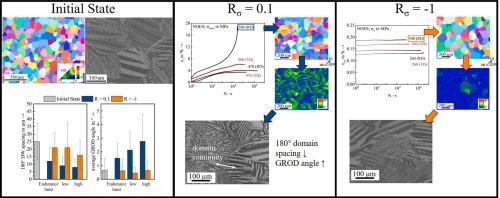Rσ = 0.1和Rσ = −1时无取向和晶粒取向电工钢的高周疲劳行为和磁畴结构
IF 6.8
2区 材料科学
Q1 ENGINEERING, MECHANICAL
引用次数: 0
摘要
研究了无取向电工钢(NOES)和晶粒取向电工钢(GOES)在滚动方向和横向两种载荷条件下的高周疲劳行为。在非对称循环荷载作用下,Rσ = 0.1的变形行为表现为强烈的棘轮。NOES在克服循环lders波段传播后的第一个周期内开始棘轮效应,而go的棘轮效应的开始是延迟的,并在潜伏期后开始。对于对称循环加载,即Rσ = -1,在试件上施加抗屈曲装置。循环变形行为以饱和状态下的弹性行为为主,循环微塑性导致材料破坏。循环加载后的磁畴结构研究表明,NOES在非对称循环加载后由于较大的塑性变形而出现了细化的磁畴结构。在对称循环加载后,由于循环加载过程中主要由弹性行为产生的塑性变形量较少,导致磁畴结构变化较小。非对称循环加载后,氧化石墨烯的磁畴结构与加载方向一致,而对称循环加载后,这种趋势不明显。本文章由计算机程序翻译,如有差异,请以英文原文为准。

High cycle fatigue behavior and magnetic domain structure of non-oriented and grain-oriented electrical steels at Rσ = 0.1 and Rσ = −1
The high cycle fatigue behavior of a non-oriented electrical steel (NOES) and a grain-oriented electrical steel (GOES) was investigated under two loading conditions with respect to the rolling direction and the transverse direction. The deformation behavior under non-symmetric cyclic loading, i.e. Rσ = 0.1 is characterized by strongly pronounced ratcheting. While ratcheting starts within the first cycle after overcoming the cyclic Lüders band propagation for NOES, the onset of ratcheting for GOES is delayed and starts after an incubation period. For symmetric cyclic loading, i.e. Rσ = -1, an anti-buckling device was applied to the specimen. The cyclic deformation behavior was characterized by mostly elastic behavior in a saturated state with cyclic microplasticity leading to material failure. The investigation of the magnetic domain structure after cyclic loading revealed for NOES a refined domain structure of the specimens after non-symmetric cyclic loading due to higher amounts of plastic deformation. After symmetric cyclic loading, the magnetic domain structure was less altered due to the lower amount of plastic deformation from mostly elastic behavior during cyclic loading. The magnetic domain structures of GOES aligned with the loading direction after non-symmetric cyclic loading, whereas after symmetric cyclic loading there was no clear tendency.
求助全文
通过发布文献求助,成功后即可免费获取论文全文。
去求助
来源期刊

International Journal of Fatigue
工程技术-材料科学:综合
CiteScore
10.70
自引率
21.70%
发文量
619
审稿时长
58 days
期刊介绍:
Typical subjects discussed in International Journal of Fatigue address:
Novel fatigue testing and characterization methods (new kinds of fatigue tests, critical evaluation of existing methods, in situ measurement of fatigue degradation, non-contact field measurements)
Multiaxial fatigue and complex loading effects of materials and structures, exploring state-of-the-art concepts in degradation under cyclic loading
Fatigue in the very high cycle regime, including failure mode transitions from surface to subsurface, effects of surface treatment, processing, and loading conditions
Modeling (including degradation processes and related driving forces, multiscale/multi-resolution methods, computational hierarchical and concurrent methods for coupled component and material responses, novel methods for notch root analysis, fracture mechanics, damage mechanics, crack growth kinetics, life prediction and durability, and prediction of stochastic fatigue behavior reflecting microstructure and service conditions)
Models for early stages of fatigue crack formation and growth that explicitly consider microstructure and relevant materials science aspects
Understanding the influence or manufacturing and processing route on fatigue degradation, and embedding this understanding in more predictive schemes for mitigation and design against fatigue
Prognosis and damage state awareness (including sensors, monitoring, methodology, interactive control, accelerated methods, data interpretation)
Applications of technologies associated with fatigue and their implications for structural integrity and reliability. This includes issues related to design, operation and maintenance, i.e., life cycle engineering
Smart materials and structures that can sense and mitigate fatigue degradation
Fatigue of devices and structures at small scales, including effects of process route and surfaces/interfaces.
 求助内容:
求助内容: 应助结果提醒方式:
应助结果提醒方式:


